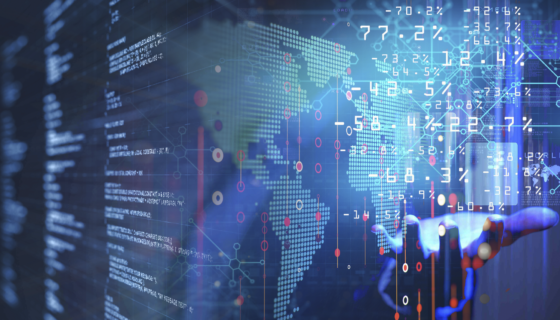A Little at First and Then All at Once: The Growing Value of Data

Data has quickly become as valuable as gold to many businesses and organizations, especially with how many products and services have evolved to be more digital than not. If we think back to merely a decade ago, or perhaps even a little farther, we already had early iterations of smartphones, tablets, and other mobile devices while computers and the Internet had quickly become a staple in our everyday lives.
In the early years of the Internet, and leading up to the days of mobile devices, collecting and analyzing data was a slow process. Information had to be stored somewhere, and companies often outsourced this storage to remote servers for later review. Keep in mind that data was a lot simpler years ago, as much of it wasn't needed the moment it was collected, but, instead, it was leveraged each quarter when discussing sales, customer behaviors, and new marketing strategies.
But times have changed, and now, in these highly connective, digital days, there is much more diverse data that allows companies of all kinds to offer much more with their products and services, and likewise, leverage that data to better their internal business processes as well.
Higher Connectivity, Convergence, and Data
When I teach companies and individuals about my Anticipatory Organization Model, we look at a multitude of characteristics both within and outside their industries. Hard Trend future certainties shaping the world in general are always referenced, many of which are disruptive digital technologies and the speed at which they are accelerating.
Convergence is another piece of the Anticipatory puzzle that I reference, which has directly to do with different technologies bringing never-before-connected industries together, creating something new that transforms the world in positive ways. How does this concept of convergence relate to data collection and processing? By way of Edge Computing!
With the ever-expanding use of low-latency 5G, Edge Computing is quickly becoming commonplace in many industries. Simply put, Edge Computing brings the processing of data closer to the collection source, which enhances a company's ability to leverage that data as quickly as possible.
Edge Computing In Auto Insurance
A notable way in which Edge Computing impacts convergence can be viewed in the insurance industry.
Many auto insurers reward drivers with lower rates, provided they drive safely, but how, exactly, is that measured accurately? In years prior, it had directly to do with how many insurance claims a driver filed after an accident. Well, looking at that from today's standpoint, that is quite inaccurate! Someone who sped dangerously, but had never filed a claim, was treated exactly the same as a person who drove excessively cautiously.
Now, thanks to speedy data collection via Edge Computing, the insurance industry has been able to converge with technology companies to develop trackers for drivers to have in their cars to offer even better rates to truly safe drivers. These trackers collect data in real-time, monitoring everything from speed to driving frequency, and so much more.
This convergence essentially carved out a new segment of an industry, creating new opportunities for entrepreneurs to better streamline these trackers, or for individual insurance companies to create proprietary equipment that could be licensed to competitors -- an act of positive disruption that sets a specific organization ahead.
Edge Computing and Everything-As-A-Service
Think of how many drivers are on the road right this second in the United States alone. That's a lot of real-time data, isn't it? Many might assume that the likes of Allstate or State Farm Insurance could afford to store all this data internally in their own servers or data centers; however, this is not always the case.
Remember, also given the increase in low-latency 5G connectivity, we now have what is referred to as "Everything-as-a-Service," or EaaS, for short. This means that data storage, or even the very act of Edge Computing, can be outsourced safely and securely to an outside organization to minimize internal overhead costs. Auto insurers using Software-as-a-Service (SaaS) for their real-time data tracking of safe and unsafe drivers can save even more and offer even better rates by lowering their overhead costs this way.
Some notable companies that offer Edge Computing services to many large organizations in expansive industries include Amazon Web Services (AWS), Dell EMC, which offers three notable categories in Edge Computing software, Google and their Edge TPU, and several others.
An Anticipatory Solution To Shipping Woes
Let's put our opportunity antennas up for just a moment and think in an Anticipatory way about data, Edge Computing, and convergence. What other industries could benefit from quick data collection and processing? Better yet, what specific industry would benefit from turning the tables to offer even better data processing to customers?
Everyone in the world, in either their professional or personal lives, has been impacted by the supply chain issues brought about by COVID-19. Especially in manufacturing, many project managers have had their specific projects delayed due to shipping issues following the pandemic, often left with nothing to say to their customers.
In leveraging Edge Computing, we could not only utilize my Skip It Principle to skip over this current problem, but we could also solve future mega-disruptions in supply chain, shipping, and communicating these challenges to customers by allowing them full transparency with tracking data. For instance, having some type of technology implemented into manufacturing processes could track in real-time where raw materials or supplies are, eventually relieving the need for project managers to constantly have to connect with different suppliers, and instead, have that legwork done for them.
This is a Hard Trend future certainty, as there are already many applications of Edge Computing in manufacturing worked effortlessly into robotics to prevent downtime and help predict when mechanical issues may be imminent.
You and your organization have the chance to benefit from better, faster data collection and processing, but likewise, use anticipation to map exactly how Edge Computing and other data collection technologies may impact other industries. In doing so, you can be the driver of positive disruption by way of convergence, bringing to light a whole new market that never before existed!









